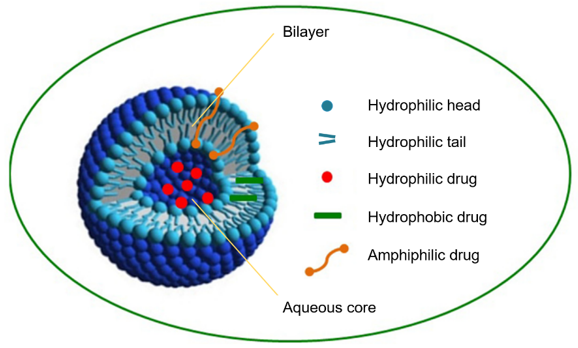Niosome Services
Non-ionic surfactant-based vesicles (niosomes) are a kind of vesicular nanocarriers composed of amphiphilic molecules surrounded by an aqueous compartment. Due to their unique advantages, niosomes have been widely used for targeted and sustained drug delivery.
The components of niosomes include surfactants (generally non-ionic surfactants), cholesterol, and charge-inducing agents. Surfactants are amphiphilic molecules that contain both hydrophobic tails and hydrophilic heads and show self-assembling properties for a variety of shapes. As the major components of niosomes, non-ionic surfactants have low toxicity and biocompatibility compared with the other types of surfactants. As a type of steroid derivative, incorporation of cholesterol affects niosomes properties such as membrane permeability, rigidity, encapsulation efficiency, rehydration, and toxicity. Also, the charged-inducing agents are used to increase the stability of niosomes by electrostatic repulsion which prevents coalescence.
 Figure 1. Schematic representation of a niosomal vesicle. (Muzzalupo R, et al., 2015)
Figure 1. Schematic representation of a niosomal vesicle. (Muzzalupo R, et al., 2015)
Niosomes are mainly applied in the delivery of pharmacological and diagnostic agents, like antioxidant, anticancer, anti-inflammatory, antiasthma, antimicrobial, anti-Alzheimer’s, and antibacterial molecules. They are involved in various routes of administration including oral, topical, transdermal, ocular, intravenous, pulmonary, and transmucosal. They are also used in different dosage forms such as powders, suspensions, and semisolids. Particularly, targeted niosomal systems have been designed with different mechanisms of action, including active, passive, and magnetic targeting. Moreover, as penetration enhancers, niosomes can overcome the barrier of transdermal drug delivery in the cosmetic industry.
Advantages associated with niosomal systems:
- Better patient compliance and better therapeutic effect
- Capability to entrap hydrophilic, lipophilic as well as amphiphilic drugs
- Controlled and sustained release of drugs due to depot formation
- Physicochemical properties can be easily controlled as required
- Greater bioavailability than conventional dosage forms
- Biodegradable, biocompatible and non-immunogenic to the body
- Better protect drug ingredients from heterogeneous factors
- Easy handling, storage, and transportation
Creative Biostructure aims to offer high-quality niosome products and services. With our years of experience, we are happy to help our clients to accelerate their research progress. Please feel free to contact us. We are looking forward to cooperating with you.
Ordering process
References
- Chen S, et al. Recent advances in non-ionic surfactant vesicles (niosomes): Fabrication, characterization, pharmaceutical and cosmetic applications. European Journal of Pharmaceutics and Biopharmaceutics. 2019. 144: 18-39.
- Muzzalupo R, Tavano L. Niosomal drug delivery for transdermal targeting: recent advances. Research and Reports in Transdermal Drug Delivery. 2015. 4: 23-33.
- Rajera R, et al. Niosomes: a controlled and novel drug delivery system. Biological and Pharmaceutical Bulletin. 2011. 34(7): 945-953.
